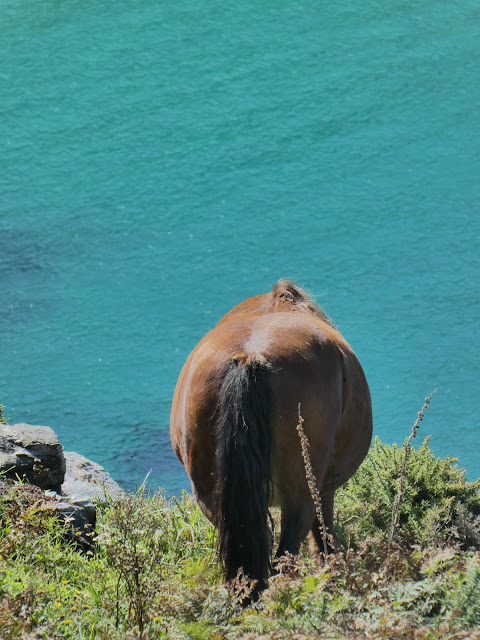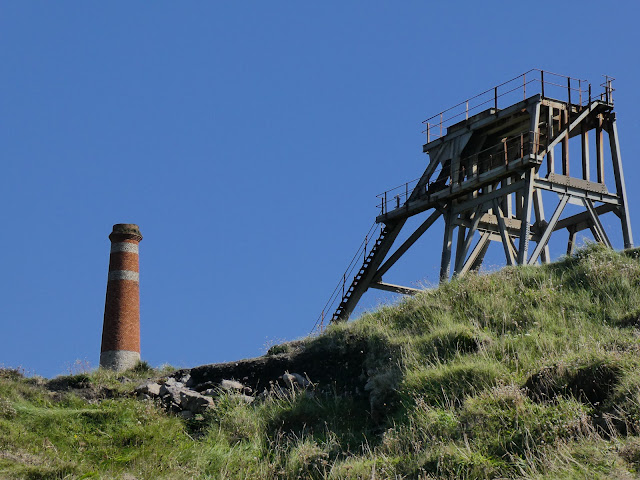We found a nice flat rock to sit on for lunch while watching, and listening to, seals.
The weather was still being kind, lighting up the blues and acquas in the clear water that made Sheryl comment how it looked tropical and making me take hundreds of photos.
There were artists painting and people swimming in secluded coves.
This is not a snake. Seriously, it isn't. About 30cm long and called a slow worm, it is actually a legless lizard. I did almost step on an adder just after this photo. That is a snake, a venomous one but again, only 30cm long.
More beautiful blues just because they are beautiful. But look closer...
Zooming in...look to the right of the darker patchThere are rock climbers on this cliff.
More blue.
Ponies are grazed along many sections of the coast to help control the vegetation. They seem remarkably relaxed about the edges of cliffs.We were so tempted to go for a swim! But someone did tell us that the water is very cold.
Heading towards the lighthouse at Pendeen Watch.
It sure is windy in Poldark country. This hawthorn tree tells the tale of years of wind.
And Sheryl's hair matches the story. It was very very windy the day we walked through an area that once had over a hundred mines with their tall chimney stacks.
Some of the mine scenes of the current Poldark series are filmed around St Just, Botallock, Levant and Geevor mines. Arsenic and copper-stained cliffs.
This day was a day of mining relics, strong wind and no trees.19th century and 20th century, side by side, silent.
In the valleys running away from the coast as well as on the cliffs.
This early bronze age chambered burial tomb was found under a pile of mine debris. I am standing on top of a structure made by people 4500 years ago!
In St Just we visited the church where another of my ancestors, Amos Mason, was the vicar in the 1600s.
The mining relics continued all the way to Cape Cornwall. Once thought to be the western-most point of England, Cape Cornwall is a couple of kms north of the actual western-most point at Lands End, and yes, that is another mine chimney on the top.
Then the geology changed again. Strange stacked rocks of coarse-grained granite.
And the lovely sandy crescent beach of Sennen Cove. One of my ancestors was a prominent citizen here back in the 1700s.
Hundreds of ships have wrecked along Cornwall's coast, this one in 2003.
Lands End, where loads of tourists pay to come and stand. There is also a huge not-very-attractive early 20th century hotel-restaurant-entertainment building that we just walked straight past to find a rock on which to sit for our lunch break.
This 38.7km section of the Path took 3 1/2 days to walk and was not done in sequence again because we are finding it harder than expected to find affordable accommodation, or any accommodation at all, at the end and start of each day's walk so we often have to use buses to get to our walks or to our bed for the night, and the bus timetable suddenly changed from summer to autumn times which in this area meant instead of a dozen services a day there were only two!
But the journey continues...





























Nice work. I admire that you find the time to put this together after a solid day's walking.
ReplyDeleteJuxtaposition of Hawthorn tree and Sheryl's hair amusing...
J.